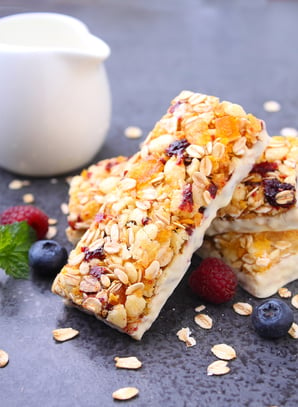 There are so many nutrition bars out there that I am sure it can be a challenge to pick one that is the best. So how do you know if the bar you are choosing is the healthiest option for you?
There are so many nutrition bars out there that I am sure it can be a challenge to pick one that is the best. So how do you know if the bar you are choosing is the healthiest option for you?
With anything, when it comes to your food and nutrition, the key is moderation and balance. You should be choosing a bar that you like the taste of and that works for your schedule and habits. The goal is to try to eat as many whole, fresh foods as possible and decrease the packaged foods with giant ingredients lists of things you might have trouble pronouncing. However, these bars can be a nice backup for snacks to keep in your purse, car, gym bag, or desk drawer for those times when you need fuel and don’t have other options.
Choosing a Nutrition Bar
Here are some good rules of thumb to follow when it comes to these convenient bars.
Protein: Choose one with at least 5 grams and no more than 15 grams. This will help keep you full and is what makes these bars have more staying power than a regular granola bar or candy bar. Too much protein will make the bar have an unpleasant taste, or more ingredients will be added to cover the added protein taste. Also, this bar is intended to be a snack to hold you over until mealtime, and not to replace the quality protein you should be getting from meals.
Fiber: Choose one with more than 3 grams. Fiber is another thing that will help keep you full, so choosing a bar with staying power will help keep you satisfied until your next meal.
Fat: Choose one with mainly heart-healthy fat. Check the label and make sure the saturated and trans fat content is low and the majority of fat is coming from mono or polyunsaturated fats like you would find in nuts.
Carbohydrates: Choose one with mostly whole grains and 15 grams or less of sugar. This can be tricky because a lot of bars have added sugar to make them taste better. Try to steer away from the ones that are a fancy candy bar and choose one that is lower in sugar.
The Most Nutritious Bars
Here are a few bars that meet these requirements:
Was your favorite not on the list, or did it not meet the requirements? Remember, if you are choosing a nutrition bar occasionally, it can fit into a balanced diet and complement your healthy eating.


 Some people think that snacking can sabotage your healthy eating plan. However, snacking keeps your energy levels up and prevents you from becoming overly hungry, which can lead to poor food choices. Eating every three to four hours can also help regulate your metabolism, which ensures that you burn calories throughout the day. Strive for at least two small snacks per day, but try to limit yourself to 100 to 150 calories or less per snack.
Some people think that snacking can sabotage your healthy eating plan. However, snacking keeps your energy levels up and prevents you from becoming overly hungry, which can lead to poor food choices. Eating every three to four hours can also help regulate your metabolism, which ensures that you burn calories throughout the day. Strive for at least two small snacks per day, but try to limit yourself to 100 to 150 calories or less per snack. The holidays are right around the corner, and the first thing that comes to mind is all that food! You don’t want to look like a Santa at the start of the New Year! Well, don’t feel guilty about consuming the goodies; just get smart! If you have an understanding of what it takes to properly fuel your body, specifically as you age, the healthy eating process doesn’t seem so daunting. Older adults have different needs, and there are some key nutrients that are really important to maintain.
The holidays are right around the corner, and the first thing that comes to mind is all that food! You don’t want to look like a Santa at the start of the New Year! Well, don’t feel guilty about consuming the goodies; just get smart! If you have an understanding of what it takes to properly fuel your body, specifically as you age, the healthy eating process doesn’t seem so daunting. Older adults have different needs, and there are some key nutrients that are really important to maintain. 
 The biggest change, however, is the fact that you no longer have to think about what’s for dinner, or lunch, or even breakfast. What a joy! My husband and I have the same exact conversation every day at around 5:30pm: What’s for dinner? I don’t know. What do you want? I don’t care. What do we have lying around that I can toss together quickly? I don’t know, eggs, a salad? And we end up usually having a salad, maybe with an omelet. Easy, but sooo boring.
The biggest change, however, is the fact that you no longer have to think about what’s for dinner, or lunch, or even breakfast. What a joy! My husband and I have the same exact conversation every day at around 5:30pm: What’s for dinner? I don’t know. What do you want? I don’t care. What do we have lying around that I can toss together quickly? I don’t know, eggs, a salad? And we end up usually having a salad, maybe with an omelet. Easy, but sooo boring.
 This is definitely my favorite time of year: football, cooler weather, and the return of all things apples and pumpkin! Not only are they chock-full of healthy goodness, but they are also delicious!
This is definitely my favorite time of year: football, cooler weather, and the return of all things apples and pumpkin! Not only are they chock-full of healthy goodness, but they are also delicious!